Synthesis, characterization, and design of molecular materials, especially molecular conductors (including superconductors), have been undertaken. Molecular conductors exhibit a variety of physical properties which can be systematically understood on the basis of "simple" and "clear" electronic structures. From a chemical point of view, the most fascinating character of the molecular conductor is its "designability", that is, we can finely control solid state properties with chemical modifications of the molecule. The newly synthesized materials are characterized by the X-ray diffraction method and physical measurements (electrical conductivity...etc.). The electronic structure is investigated by the band structure calculation. All these results are devoted to the design of new molecular materials.
- Fine control of anisotropy of triangular-lattice in mixed cation salts of Pd(dmit)2 and realization of the quantum spin liquid state
- Antiferromagnetic state near the quantum spin-liquid
- Spin correlation and dynamics of the molecular conductors
- Electronic state of molecular conductors including 5d transition metal
- High-pressure resistivity measurement under high quality hydrostatic condition
- High-density carrier doping into an organic Mott insulator using electric-double-layer transistor
- Low-temperature carrier transport of organic Mott FET
- Light-induced superconductivity in an organic Mott insulator using a photo-active electric double layer
- Broken valley symmetry by electric field in molecular Dirac fermion systems
- First-principles study of proton coupled charge disproportionation state in hydrogen bonded molecular conductors
- Thermoelectric power dependence at the Mott transition in Pd(dmit)2 based compounds
- Fine control of anisotropy of triangular-lattice in mixed cation salts of Pd(dmit)2 and realization of the quantum spin liquid state
- Antiferromagnetic state near the quantum spin-liquid
- Spin correlation and dynamics of the molecular conductors
- Electronic state of molecular conductors including 5d transition metal
- High-pressure resistivity measurement under high quality hydrostatic condition
- High-density carrier doping into an organic Mott insulator using electric-double-layer transistor
- Low-temperature carrier transport of organic Mott FET
- Light-induced superconductivity in an organic Mott insulator using a photo-active electric double layer
- Broken valley symmetry by electric field in molecular Dirac fermion systems
- First-principles study of proton coupled charge disproportionation state in hydrogen bonded molecular conductors
- Thermoelectric power dependence at the Mott transition in Pd(dmit)2 based compounds
Assign: Ueda, Cui, Kato; Fukunaga, H. Yamamoto
The quantum spin liquid (QSL) state is realized owing to the geometric frustration on a two-dimensional (2D) triangular lattice. Many experimental and theoretical studies have been done for the QSL state in EtMe3Sb[Pd(dmit)2]2. The quantum state of QSL, however, has not been clarified yet. Almost all anion radical salts (Cation)[Pd(dmit)2]2, including the EtMe3Sb salt, are isostructural. In the crystal, spin 1/2 units, [Pd(dmit)2]2-, form a 2D isosceles triangular lattice, which is characterized by a frustration parameter t'/t, where t and t' are inter-dimer transfer integrals. The frustration parameter can be tuned by changing counter cation. A t'/t -T phase diagram contains various magnetic ground states depending on t'/t; QSL (t'/t ü`1), antiferromagnetic long-range order (AFLO) in the smaller t'/t region (for example Me4As and Et2Me2As salts), and charge order (CO) in the larger t'/t region (Et2Me2Sb salt). For the more detailed understanding of the t'/t -T phase diagram, continuous control of t'/t values was desired.

Figure 1: Pd(dmit)2 molecule
We thus synthesized the Pd(dmit)2 salts in which t'/t can be finely controlled by using mixed cation [1]. The homogeneous mixed salts with variable cation ratio were obtained. The mixing ratio and homogeneity of obtained salts were characterized with ESI mass spectroscopy and EPMA. The lattice parameters and t, t' values linearly changed against the cation mixing ratio, which indicates that anisotropic chemical pressure effect on the triangular lattice depends on the mixing ratio. We measured magnetic susceptibility (χ) of mixed cation salts down to 2 K by MPMS to studied the magnetic behavior in the t'/t -T phase diagram. For every mixed salt, the temperature dependent magnetic susceptibility shows a broad peak like pristine salts. This behavior is well explained by the high temperature expansion calculations for the 2D Heisenberg antiferromagnet on the triangular lattice with Jü`200 K. The peak of χ is due to the competition between short-range magnetic order and spin fluctuation from the geometric frustration. A theoretical study indicated that the peak temperature and χ value at the peak temperature are related to the J ratio in the isosceles triangle lattice. Each of them for the Pd(dmit)2 salts shows linear change on t'/t as shown in Fig. 2. This result indicates that the degree of frustration is closely correlated to t'/t.
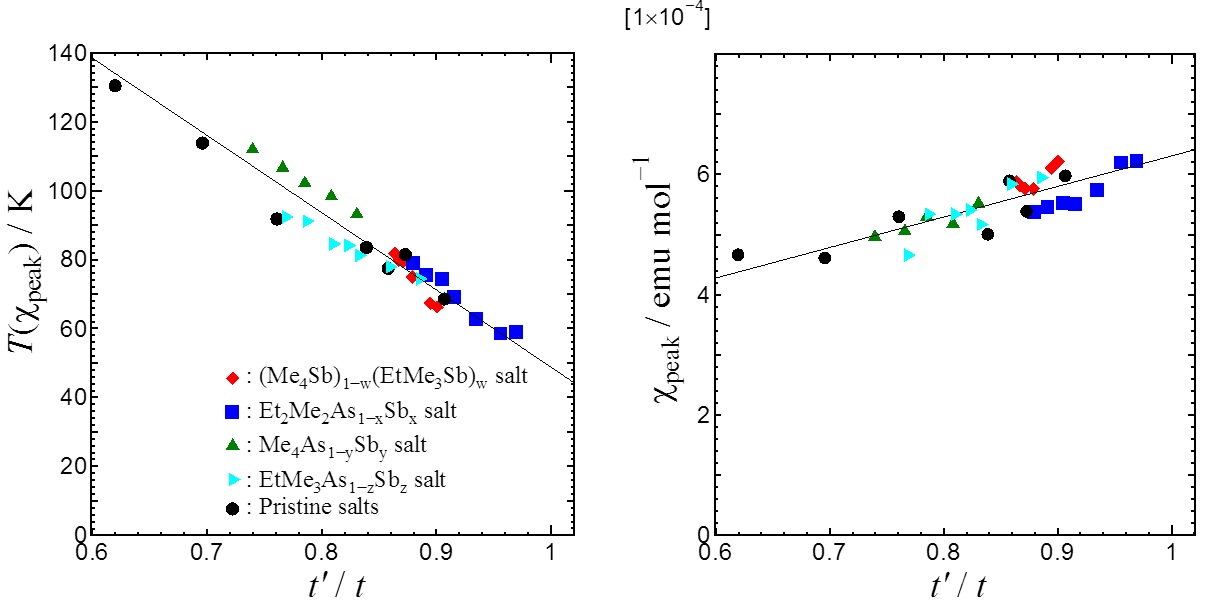
Figure 2: t'/t dependence of peak value of magnetic susceptibility and peak temperature
Figure 3 shows a refined t'/t -T phase diagram. Around the QSL state, the AFLO transition and the CO transition are quickly suppressed. Mixed salts situated between the AFLO and CO phases (for example, Me2Et2As1-xSbx salts with 0.25≤x≤0.65) showed no phase transition down to 2 K. These mixed salts exhibited a gapless excitation in the heat capacity measurement as was observed in the EtMe3Sb salt. These results mean that the QSL state exists as a phase within a certain range of t'/t, and the QSL phase can be realized by the control of the frustration in the mixed salts. The abrupt change of transition temperature is observed only near the boundary between the AFLO and QSL phases, whereas the Néel temperature (TN) for Me4As1-ySby salts far from the boundary changed almost linearly against t'/t. To understand more detailed feature of the QSL phase, magnetic behavior depending on t'/t was systematically studied.
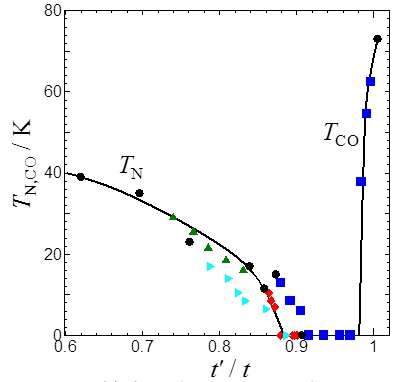 |
 |
|
| Figure 3: t'/t-T phase diagram | Figure 4: Free spin concentration |
In all materials, a small amount of Curie-like para-magnetic contribution (free spin) is generally observed due to existence of chemical impunities and crystallographic defects. However, we found an anomalous enhancement of free spin concentration against t'/t. In the QSL salts including mixed crystal, the concentration of free spins was enhanced by about 10 times larger than that in the AFLO salts (Fig. 4). The free spin concentration remains almost constant in the QSL phase and shows an abrupt jump at the boundary between the AFLO and QSL phases, which suggests that the enhancement reflects an intrinsic quantum state of QSL phase rather than the disorder effect.
The QSL salts showed no magnetic anisotropic behavior down to 2 K. For the AFLO salts situated far from the QSL phase, magnetic susceptibilities perpendicular and parallel to the 2D plane split below TN, and the easy direction of the magnetization was revealed to be the perpendicular direction to the 2D plane. On the other hand, the AFLO salts near the phase boundary including the Me4Sb salt did not show the magnetic anisotropy and spin-flop transition, even though magnetic susceptibility and 13C NMR measurements indicate the AFLO transition. These results suggest that strong magnetic fluctuation exists near the phase boundary.
References
[1] R. Kato et al., Phys. Status Solidi, B249(5), 999-1003 (2012).
Assign: Fujiyama, Ueda, Kato
A series of anion radical salts (Cation)[Pd(dmit)2]2 contains a candidate magnetic material for a quantum spin-liquid that shows no classical magnetic ordering. The [Pd(dmit)2]2 dimers containing S=1/2 realize a triangular lattice and results in a frustration of antiferromagnetic correlations. The magnetic phase diagram has been summarized as a function of the anisotropy of the interdimer transfer integrals, t'/t, and indeed, the quantum spin-liquid phase is located near the regular triangular point, t'/t=1.
The ground states of materials with t'/tüā1 are antiferromagnetic ordered states. The antiferromagnetic ordering temperature TN are estimated TN = 11K (Cation=Me4Sb) and TN=40K (Me4P). We performed 13C NMR measurements for these materials. We estimated the hyperfine coupling constants of 13C sites as 2.16 and 2.61 kOe/μB using ab initio calculation. The estimated magnitudes of ordered moments are 0.6 μB (Me4P) and 0.27μB (Me4Sb) at 10K where magnetic moments are nearly saturated. Of these, the magnetic moment in the Me4P salt is reduced by a low dimensional fluctuation caused by the two dimensional magnetic network, which is frequently observed in layered materials. On the other hand, the magnetic moment in the Me4Sb salt is apparently reduced by the other origin than low dimensional fluctuation, which suggests considerable quantum fluctuation toward quantum spin liquid regardless of the phase transition between the antiferromagnet and quantum spin-liquid.
We also found an anomalous structure in the antiferromagnetic resonance spectra of the Me4P salt. The structure is visible only in the ordered state, which excludes the possibility of the Coulomb repulsion as the origin. A recent theoretical approach, which treats the electronic correlations of left- and right- side electrons in the dmit ligands over the central Pd metal independently, proposes a charge disproportionation only in the antiferromagnetic state [1]. Our result is consistent with the proposal, and strongly supports the model in which intra-molecular degree of freedom is fully took into account.
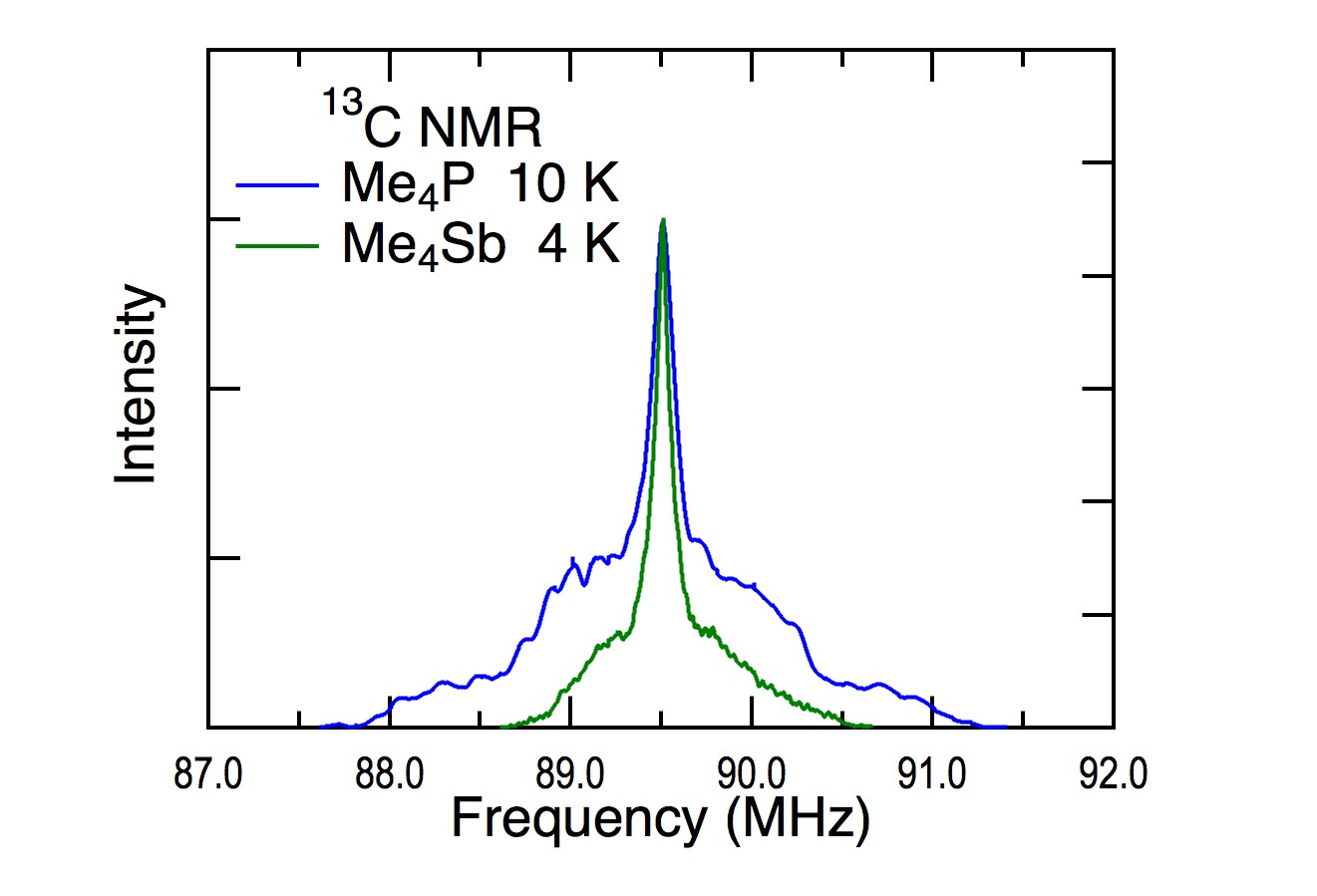
Assign: Oshima, Kato
The anion radical salts X[Pd(dmit)2]2, where X is a monovalent cation, are Mott insulators which consist of a S=1/2 triangular lattice of the anion dimer [Pd(dmit)2]2 [1]. These salts have attracted attention over the years since spin-frustration parameters t'/t can be controlled by substituting the cation X as shown in Fig. 1. The Me4P salt has a highest Néel temperature TN=40 K with t'/t close to 0.6. Then, TN decreases as t'/t getting closer to an isotropic triangle (t'/tü`1) where TN for the Et2Me2P and Me4Sb salts are 14 K and 11 K, respectively.
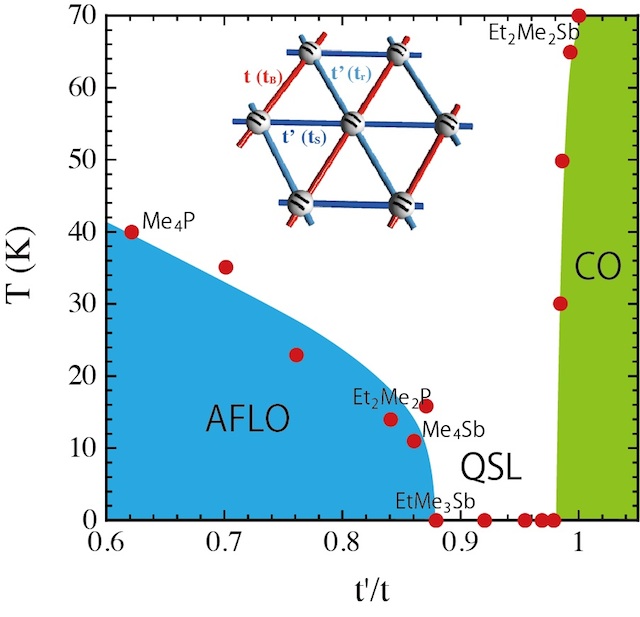
Figure 1: Phase diagram of X[Pd(dmit)2]2. Each plot represents the transition temperature and t'/t (t', t :Interdimer transfer integral) for each X[Pd(dmit)2]2 salt. AFLO, QSL and CO are antiferromagnetic long-range order, quantum spin liquid and charge order.
Things get more complicated with the recently reported ab-initio calculations suggesting the transfer integrals within the triangular lattice are all non-equivalent [5]. Moreover, the frustration parameters t'/t, which are used in Fig. 1, were obtained from extended Hückel calculations where the transfer integrals are calculated from the crystal structure at room temperature. However, recent structure analysis suggests that triangular lattice is more anisotropic at low temperature, which reduces the spin-frustration. So, questions arise why there is no long-range order with such a distorted triangular lattice. In principle, the effect of charge fluctuations and the exchange interaction along the interlayer direction might be the cause for no long-range ordering. Therefore, experimental evidences of the spin correlations in this system were highly anticipated.
To understand more deeply the phase diagram and investigate the spin correlations in X[Pd(dmit)2]2, we have performed in-plane ESR measurements on X=Me4P, Et2Me2P, Me4Sb and EtMe3Sb. The X[Pd(dmit)2]2 system contains two layers of triangular lattice in the unit cell, where the stacking direction of the Pd(dmit)2 dimers are different for each layer. These are crystallographically equivalent, however g-tensor for each layer is expected to be different since the stacking direction of the dimers are different. It is well known that if exchange interaction exists between two spins with different g-tensor, the two independent ESR absorption lines merge to a single absorption. The merging depends on the relation between the exchange energy J and the Zeeman energy, 2üŃ2Jü`δgμBB. Therefore, interlayer exchange interaction J can be evaluated by rotating the magnetic field parallel to the triangular lattice. Moreover, spin dynamics within the triangular lattice can be investigated by analyzing the in-plane angular dependence of ESR linewidth.
We show in Fig. 2 the in-plane angular dependence of the ESR spectra for the Me4P and EtMe3Sb salts. Although two ESR absorptions coming from two independent anion layers are observed for the EtMe3Sb salt, only a single absorption is observed for the Me4P salt (TN=40 K). These results suggest the interlayer exchange interaction is finite, estimated ca. 0.37 mK, for X = EtMe3Sb and infinitesimal for X = Me4Sb. Two absorption lines were observed also for the Me4Sb salt (TN=11 K) where J is estimated around 1.58 mK. For the Et2Me2P salt (TN=14 K), two Lorentzian components were observed in the ESR absorption but due to the lack of enough magnetic field only a rough estimation of Jüä76 mK could be obtained. However, it is found that TN is related with the interlayer exchange interaction. Moreover, the in-plane angular dependence of the ESR linewidth for the EtMe3Sb salt shows some features reflecting the non-equivalent triangular exchange interactions. Linewidth minima are observed when the magnetic field is applied along the strongest and second-strongest triangular exchange path, and a maximum is observed for the weakest triangular exchange path. These behaviors are observed in each layer. Therefore, the distortion of the triangular lattice is also observed in our results.
In summary, we have performed in-plane ESR measurements on the Me4P, Et2Me2P, Me4Sb and EtMe3Sb salts. Our ESR measurements have revealed that interlayer exchange interaction is strongly related to TN. However, it is still unknown whether the infinitesimal interlayer interaction is an intrinsic effect of the cations. It is possible that it is a pseudo effect due to the strong spin fluctuations, which are induced by spin-frustration. Theoretical calculations of the exchange interactions in this system are needed.
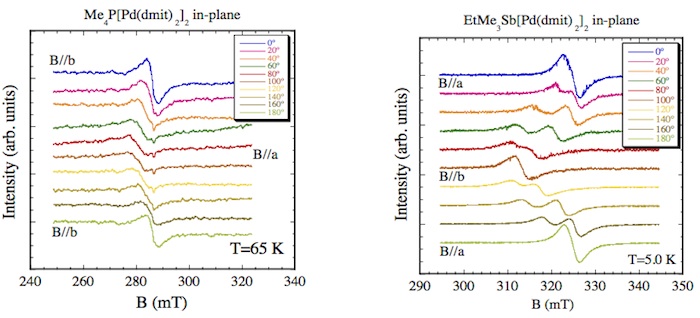
Figure 2: Angular dependence of the ESR spectra for X=Me4P and EtMe3Sb. Two ESR lines coming from two individual layers are observed for X=EtMe3Sb, suggesting the lack of interaction between the layers.
[1] R. Kato, Bull. Chem. Soc. Jpn., 87, 355 (2014).
[2] S. Yamashita et al., Nature Commun., 2, 275 (2011).
[3] M. Yamashita et al., Science, 328, 1246 (2010).
[4] T. Itou et al., Nature Phys., 6, 673 (2010).
[5] T. Tsumuraya et al., J. Phys. Soc. Jpn., 82, 033709 (2013).
Assign: Fujiyama, Kawasugi, Kato
Spin-orbit coupling in solids attracts increasing interest in condensed matter physics because of its crucial effect on a realization of spin currents or related novel spin phenomena. In molecular conductors, so far, the spin-orbit coupling is regarded as negligible in the band structures that describe physical properties because the masses of most elements composing molecules are light.
Anion radical salts (Cation)[Pt(dmit)2]2 that are related molecular conductors with a spin-liquid candidate EtMe3Sb[Pd(dmit)2]2. Temperature dependences of resistivity for the series show metal-insulator transition at TMI = 160 - 220 K depending on the cations. This transition accompanied by the structural change is ascribed to a charge disproportionation associated with the HOMO-LUMO inversion in the band structure. The electronic state below TMI is expected to be a band insulator where [Pt(dmit)2]20 and [Pt(dmit)2]22- ionic dimers are alternatingly arranged. The susceptibility becomes nearly zero below TMI, which supports the physical picture of the phase transition. On the other hand, a visible temperature dependent susceptibility above TMI does not agree to the conventional Pauli-paramagnetism and suggests unknown electronic correlation. (T. Ishikawa et al. Science, 350, 1501 (2015))
We performed 13C NMR measurements of Me4P[Pt(dmit)2]2 that shows the metal-insulator transition at Tü`220K to explore the electronic state of this material. The nuclear spin-lattice relaxation rate (1/T1) shows an abrupt reduction below 210K, which evidences an opening of a gap for spin excitation and supports the band-insulator picture below TMI.
However, the 1/T1 above TMI is nearly independent of temperature. The result poses contradiction to the resistivity that shows a positive slope against temperature. Instead, the electronic state should be regarded as a Mott insulator as a bulk form. We can point out a possibility that the paths of the electronic transport are confined on the surface of the material.
The values of 1/T1 at room temperatures are strongly reduced down to 1/5 of that of (Cation)[Pd(dmit)2]2. Since the susceptibilities of (Cation)[Pt(dmit)2]2 are nearly 1.5 times enhanced compared to those of (Cation)[Pd(dmit)2]2, the hyperfine coupling of 13C in (Cation)[Pt(dmit)2]2 is nearly half of that in (Cation)[Pd(dmit)2]2. The local electronic state at the molecular dimers is strongly modified by replacing Pd to Pt that induces strong spin-orbit coupling.
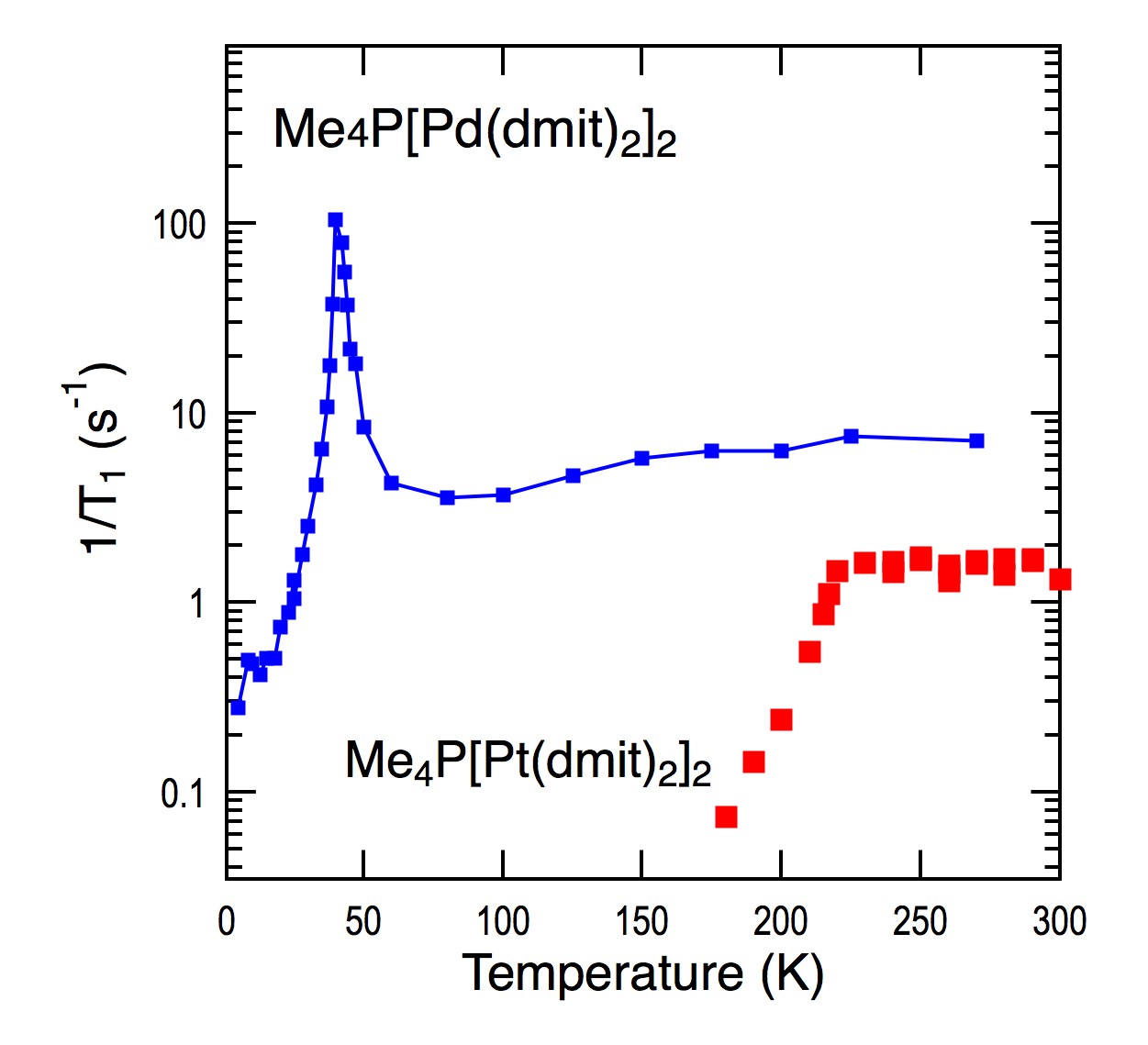
Assign: Cui, Kato; Bangura
To gain an understanding of the physical properties of materials up to extremely high pressure, the quality of high pressure environment plays a critical role. However, due to the limitation of the strength of materials used in high pressure equipment, most measurement are only performed below 10 GPa. Measurements under pressures higher than 10 GPa require the use of diamond anvil cell (DAC) technology, which has been thought to have limitation in terms of the hydrostaticity of the high pressure environment. Usually, the cubic anvil cell (CAC) press, in which pressure is applied with six anvils, is employed when really high quality hydrostatic pressure is required. In a DAC the pressure generated with only two anvils, meaning that the high pressure environment cannot be controlled as well as it can in the case of a CAC. Very recently, we proved that modified DAC technique for four-probe resistivity measurement also can provide a high quality hydrostatic condition, and found a pressure induced superconductor in the single-component organic molecular crystal [1]. We describe here the modified DAC technique for four-probe resistivity measurement, including the full detail of sample mounting technique in a DAC. Using this technique, we performed high pressure transport measurements for a Mott insulator β'-Et2ICl2üiET = Bis(ethylenedithio)tetrathiafulvaleneüjup to 12 GPa. By comparing the result obtained by the cubic anvil cell measurement, we proved that a choice of small culet size, small samples, and encapsulating the sample provides high quality hydrostatic pressure in DAC [2].

Figure 1: The pictures of DAC and pressure device.
Organic conductors of β'-Et2ICl2 is a Mott insulator at ambient pressure. The magnetic susceptibility measurement shows this salt has an antiferromagnetic ground state, with onset TN of 22 K [3]. Under high pressure, the insulating state is gradually suppressed and a metallic state appears at 6.5 GPa up and at room temperature. Under 8GPa, the ICl2 salt becomes superconducting at 14.2 K [4]. Before the advent of the CAC technique, high pressure measurements of the electrical properties for the ICl2 salt were performed using DAC. In one case, the system shows metallic state down to 80 K under 8.3 GPa, but no superconducting state was found even up to 10.4 GPa. In fact the room temperature resistivity starts increasing above 8.3 GPa and the temperature dependent resistivity is semiconductor-like, which was understood as coming from some kind of solid state transformation [5]. In the second previously reported DAC measurement where a turn-buckle type of DAC were used up to 8.3 GPa, the resistivity starts to decrease at 12.4 K. This downturn in the resistivity was suppressed by applying magnetic field, confirming its origin as the onset of a superconducting state. [6].
In this work, a DAC with culet diameter of 0.7mm was used in combination with gaskets made of tension annealed stainless steel SUS301. Daphne oil 7373 was used as a pressure transmitting medium. The sample mounting process for the high pressure electrical transport measurement is shown in Fig. 2. As shown in Fig. 2a, the samples were cut to bars of approximately 0.12x0.03x0.02mm3. The 5 μm gold wires were attached to a sample with gold paint to make four contacts and a thin layer of Al2O3-reinforced epoxy was used to encapsulate the sample. For preparation of 5 μm gold wires, after pressurize 10 μm gold wire to ü`20 μm bars and then cut to four wires by a razor (Figs. 2b, 2c). The pressure in the transmitting medium was determined by ruby fluorescence of R1 line which was outside of the encapsulation. Our result shows that at ambient pressure the system shows a semiconducting behavior with activation energy of 103 meV. Both room temperature resistivity and activation energy gradually decreased with applying pressure. Under 8.4 GPa, a metallic state was observed down to 150 K. At 8.9 GPa, a small kink appears around 14 K, and this behavior was similar to the CAC result at 7.5 GPa. Subsequently, electrical properties were measured up to 10.1 GPa, and the superconducting state appeared at 13.8 K. The magnetic field suppressed the transition temperature with about 2K / T at 10.1 GPa. In comparison to the two previously reported DAC measurements, we successfully reproduced the pressure and temperature dependence of resistivity data comparable to that obtained by the CAC technique. The use of a smaller culet size, smaller sample, and encapsulation layer could be the reason for the high quality hydrostatic pressure. Due to the small sample size, only small amounts of contact paint can be used to attach the wire to the sample, which makes the contacts extremely fragile and prone to being peeled off the sample when the gasket shrinks. The encapsulation step protects the contacts, and this protective layer also prevents the sample from being damaged by the solid pressure medium at high pressure. Compared to the CAC equipment, the DAC has excellent characteristics including low cost and generation of higher pressure by selecting a small curette surface. Furthermore, it is also possible to design a small cell that can be easily rotated in a magnetic field. We believe that our DAC technique will open new possibilities for extreme condition research in molecular materials.

Fig. 2: The process of (a) sample cutting (b), (c) preparation of 5 m gold wires (d) attaching four gold wires on the sample with gold paint (e) setting on the gasket (f) encapsulating of the sample
References
[1] H. Cui, H. Kobayashi, S. Ishibashi, M. Sasa, F. Iwase, R. Kato, A. Kobayashi, J. Am. Chem. Soc., 136, 7619 (2014). [2] H. Cui, A. F. Bangura, and R. Kato, The Review of High Pressure Science and Technology, 25, 292 (2015).
[3] M. Tokumoto, H. Anzai, T. Ishiguro, G. Saito, H. Kobayashi, R. Kato and A. Kobayashi, Synth. Met., 19, 215 (1987).
[4] H. Taniguchi, M. Miyashita, K. Uchiyama, K. Satoh, N. Mori, H. Okamoto, K. Miyagawa, K. Kanoda, M. Hedo, Y. Uwatoko, J. Phys. Soc. Jpn., 72, 468 (2003).
[5] T. Adachi, E. Ojima, B. Zh. Narymbetov, H. kobayashi, T. Miyazaki, M. Tokumoto, Chem. Lett., 406 (2000).
[6] Äļ¢ņé▌é®, ĢėōyÉ│Él, ÅŃÅ░ö³¢ń,ŗ{ē║Ž, ÆJī¹ŹOÄO, Źéł│Ś═é╠ē╚ŖwéŲŗZÅp, 15, 333 (2005).
Assign: Kawasugi, Sato, Kato; Seki, Edagawa, Pu, Yunoki, Takenobu, H. Yamamoto
A Mott insulator is insulating because of the strong electron-electron interaction although it should be a metal according to the band theory. Since the discovery of high-temperature superconductivity, which emerges when charge carriers (electrons or holes) are doped into certain types of Mott insulator, the effect of carrier doping into Mott insulators have been one of the central issues in the condensed matter physics. Among molecular conductors consisting of organic molecules, there are some material groups in which a superconducting phase borders the Mott insulating phase. Common nature with the high-temperature superconductors has been discussed on those materials, such as BEDT-TTF and Pd(dmit)2 salts. However, precise chemical doping by element substitution has been limited in molecular conductors because of the difficulty of synthesis. In this study, we tried carrier doping into an organic Mott insulator using an alternative doping method, electric-double-layer transistor (EDLT).
In the previous year, we succeeded in fabrication of EDLTs based on κ-(BEDT-TTF)2Cu[N(CN)2]Cl (κ-Cl hereafter) and found that the EDLT could induce charge carriers at least four times as much as that of conventional field-effect transistor. The resistance of κ-Cl decreased by orders of magnitude under both electron and hole doping. As a result, we achieved the measurement of the Hall effect both on the electron- and hole-doped states in the same κ-Cl crystal. According to the Hall effect, the doping of electron delocalizes the solidified carriers which are originally localized due to the electron-electron interaction (reconstruction of the Fermi surface). On the other hand, the number of delocalized carriers under the hole doping is only one third of that under the electron doping. We speculate that this is because the Fermi surface under hole doping is partly suppressed by the pseudogap.

Fig. 1: Effect of carrier doping in the resistivity (a) under hole doping and (b) electron doping. Semiconducting behavior was suppressed by both electron and hole doping. (c) Gate voltage dependence of the carrier density estimated from the Hall effect.
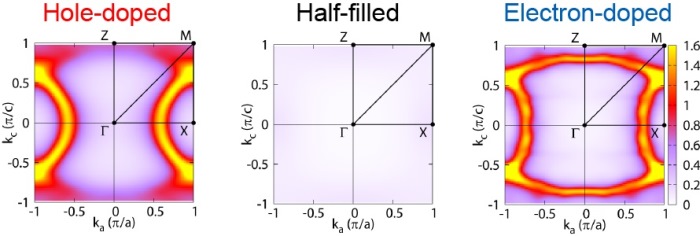
Fig. 2: Fermi surface of the Hubbard model on an anisotropic triangular lattice (t'/t = -0.8, U/t = 7, t = 55 meV, T = 30 K) calculated by cluster perturbation theory (Dr. Seki).
This year we investigated this speculation by collaborating with Dr. Seki from Yunoki group. We calculated the single-particle spectral function of the Hubbard model on an anisotropic triangular lattice. First, the Mott insulating state is reproduced in the non-doped state (Fig. 2 center). With the doping of electrons (Fig. 2 right), a non-interacting-like Fermi surface appears as expected by the Hall effect measurement. Under hole doping (Fig. 2 left), the Fermi surface is seemingly reconstructed as well as electron doping. However, the spectral density near the Z-point is strongly suppressed by pseudogap. In this state, the carrier density estimated from the Hall effect is expected to be approximately one third (corresponding to the closed lenslike orbit) of that in the electron-doped state. Namely, the results of the Hall effect measurement can be explained by the above calculations. The doping asymmetry can be interpreted from the non-interacting band structure of κ-Cl as follows. The effect of electron interaction is weakened when the band filling is deviated from 1/2 by both electron and hole doping. However, a van Hove singularity lies below the Fermi level near Z-point in the non-doped state. Therefore, the Fermi level approaches the van Hove singularity by hole doping and the effect of electron interaction remains stronger in the vicinity of Z-point. On the other hand, the Fermi level departs from the van Hove singularity under electron doping, resulting in a relatively non-interacting Fermi surface.
The above calculations predict that the resistivity in the hole-doped state is more anisotropic compared to that in the electron-doped state, because of the anisotropic pseudogap state. We fabricated cross-bar-shaped samples to examine this. As shown in Fig. 3, anisotropy in the resistivity was stronger in the hole-doped state, where the resistivity along the pseudogap direction became higher.
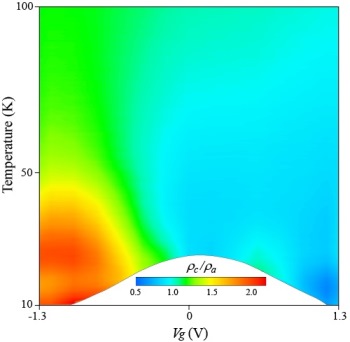
Fig. 3: Anisotropy in the resistivity along the c- and a-axes (both in-plane).
The light blue region denote isotropic conduction and c-axis resistivity is higher in the red region.
Thus, EDLT carrier doping into an organic Mott insulator revealed a clear doping asymmetry that originated from the band structure. The calculations based on simple Hubbard models well reproduced the experimental results. Our future prospects are emergence of superconductivity by further carrier doping and investigation of its doping asymmetry.
Assign: Sato, Kawasugi, Kato; H. Yamamoto
Low-dimensional electron systems, where the motion of electrons is spatially confined, have been intensely studied since competition between electron correlation and a variety of quantum effects plays a key role for emergence of complex physical phenomena. Particularly, the metal-insulator (MI) transition is one of the most important issues being closely related to (de-)localization of quasiparticles and its wave-particle duality. So far, the MI transition in widespread materials with different carrier density and electron correlation strength has been explored, whereas its nature remains to be comprehensively understood. κ-(BEDT-TTF)2[Cu(CN)2]Cl (κ-Cl) is one of the strongly-correlated molecular conductors classified with quasi-two-dimensional Mott insulator, whose electronic feature is controlled by strong Coulomb repulsion between carriers at low temperature. Due to the fact that charge injection on Mott insulators can delocalize carriers, we have successfully realized filling-induced Mott transition by manufacturing field-effect transistors (FETs) channeled with single crystal of organic Mott insulators such as κ-Cl. Since the electrostatic doping on FETs enables us to finely tune the doping density without introducing any impurities, it is an ideal method to investigate the nature of Mott transition.
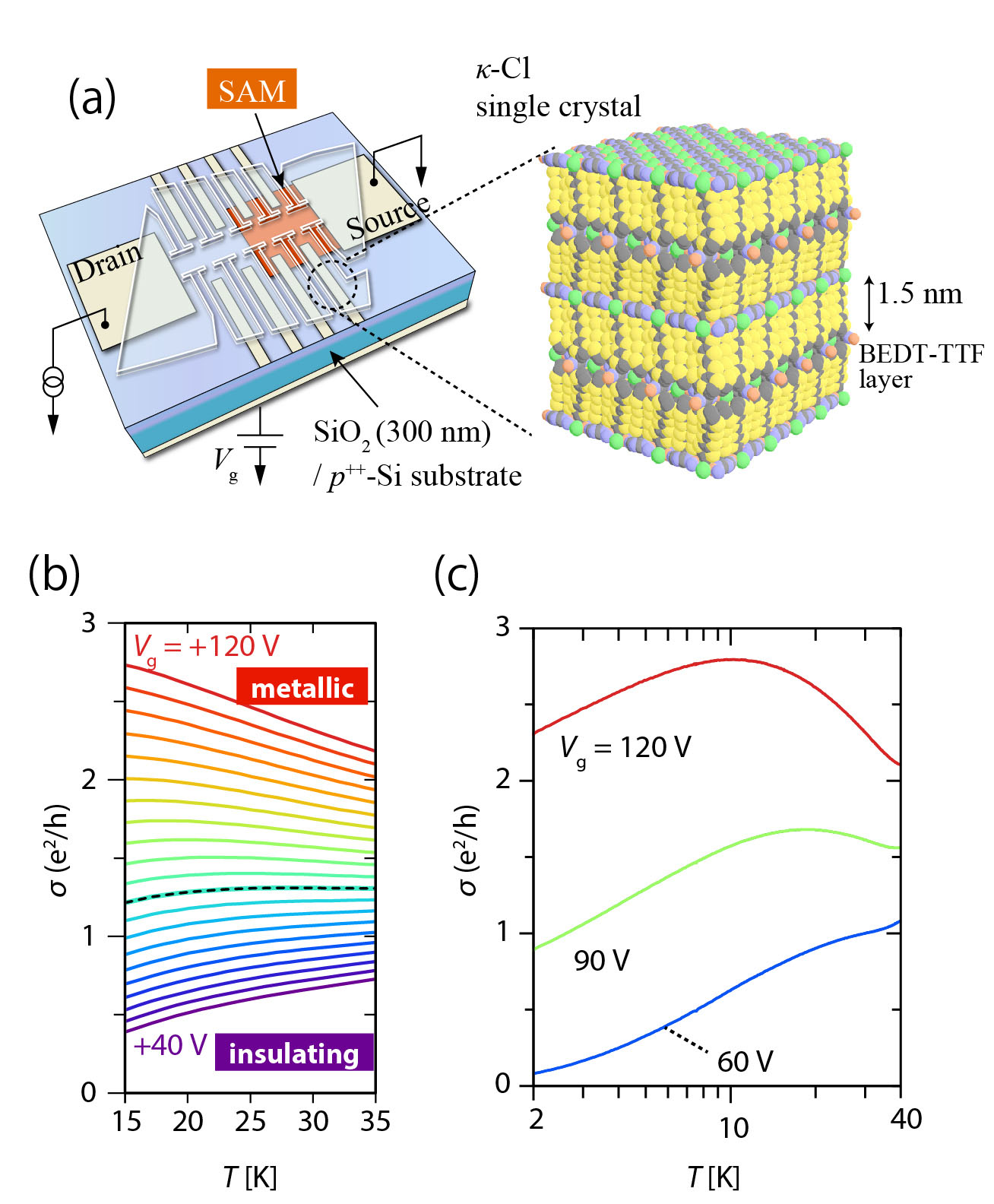
The feature of filling-controlled MI transition on κ-Cl FETs can be summarized as follows: (1) Carrier transport properties of doped κ-Cl is significantly dependent on disorders on the interface of FETs (e.g. roughness of the surface of κ-Cl crystal, cleanness of gate dielectric/channel interfaces, etc.). Metallic transport has been observed only for the device fabricated from κ-Cl crystal with flat surface of which the surface roughness is suppressed below molecular size level (thickness of BEDT-TTF layer : 1.5 nm). (2) Minimum metallic conductivity is σc0ü`e2/h (e: charge of electron, h: Planck constant). Specifically in the middle-low temperature range (T=20-35 K), an unambiguous MI transition point exists, where the temperature coefficient of conductivity is zero, i.e., σ(T)=σc0. (3) The transition is a continuous one, and importantly, conductivity in the vicinity of MI transition point satisfies the quantum critical scaling law: σ(nüAT)=F(|x-xc|/T1/ā╦z ) (ā╦ and z are critical exponents which depends on the universality class of the transition, and x is the controlling parameter corresponding to gate voltage Vg in our system). (4) Around MI transition point, carrier density estimated from Hall coefficient is almost completely constant (ü`1014 cm-2, corresponding to one hole per BEDT-TTF dimer) and does not changes by such a small amount of doping that is achieved by electric field effect. On the other hand conductivity itself changes sensitively by doping, indicating that change in the carrier mobility is the major contribution in filling-induced MI transition. (5) Toward lower temperature (Tüā20 K), carrier transport around σü`σc0 becomes weakly insulating in a crossover-like manner, and finally at T≤10 K, logarithmic correction in temperature dependence of conductivity āóσü`(e2/h) log T manifests itself. While criticality of transition is similar to that of conventional two-dimensional electron gas such as GaAs, carrier density and details of transport (e.g. T-dependence of conductivity) seem to deviate from conventional ones.
To more elucidate phase competition and microscopic origin of MI transition on κ-Cl, low-temperature carrier transport properties were measured systematically around MI transition point. Figure 2 shows magnetoresistance (MR) at T=2 K for out-of-plane magnetic field. In contrast to the fact that carrier transport becomes entirely insulating in the whole measured range of doping density for Tüā5 K, MR exhibited a clear dependence on doping in association with sign reversal of MR. In highly doped regime (σüŌe2/h), negative MR was observed with the magnetic field angle dependence of MR(θ)üÕB cosθ (θ:angle with respect to the normal direction). This is consistent with two-dimensional weak localization behavior, which is expected for sufficiently weak electron correlation. The decoherence length LΦ (reflecting lifetime of quasiparticles) exhibited a power-law temperature dependence, the exponent of which increased with increasing doping. On the other hand, in lightly doped regime (σüß0.1 e2/h), positive MR greater than 10 % was observed. Here, we also found in this regime that the system showed the feature of the strongly localized Mott insulator (e.g. very rapid decrease of conductivity by reducing doping, nonlinear conductivity similar to the one seen in the bulk κ-Cl). Thus, the positive MR implies the existence of a spin-dependent transport gap, which probably stems from Mott-Hubbard gap. For intermediate regime of σü`[0.1-1] e2/h corresponding to the critical region at middle-low temperature, no distinct MR was confirmed and it seems that the system is within the transient region between weakly and strongly localized regime. Carrier transport at low temperature is complicated, but as seen in Figure 3, its background is likely to be closely related to the mechanism that causes MI transition at middle-low temperature.
(BEDT-TTF = bis(ethylenedithio)tetrathiafulvalene)
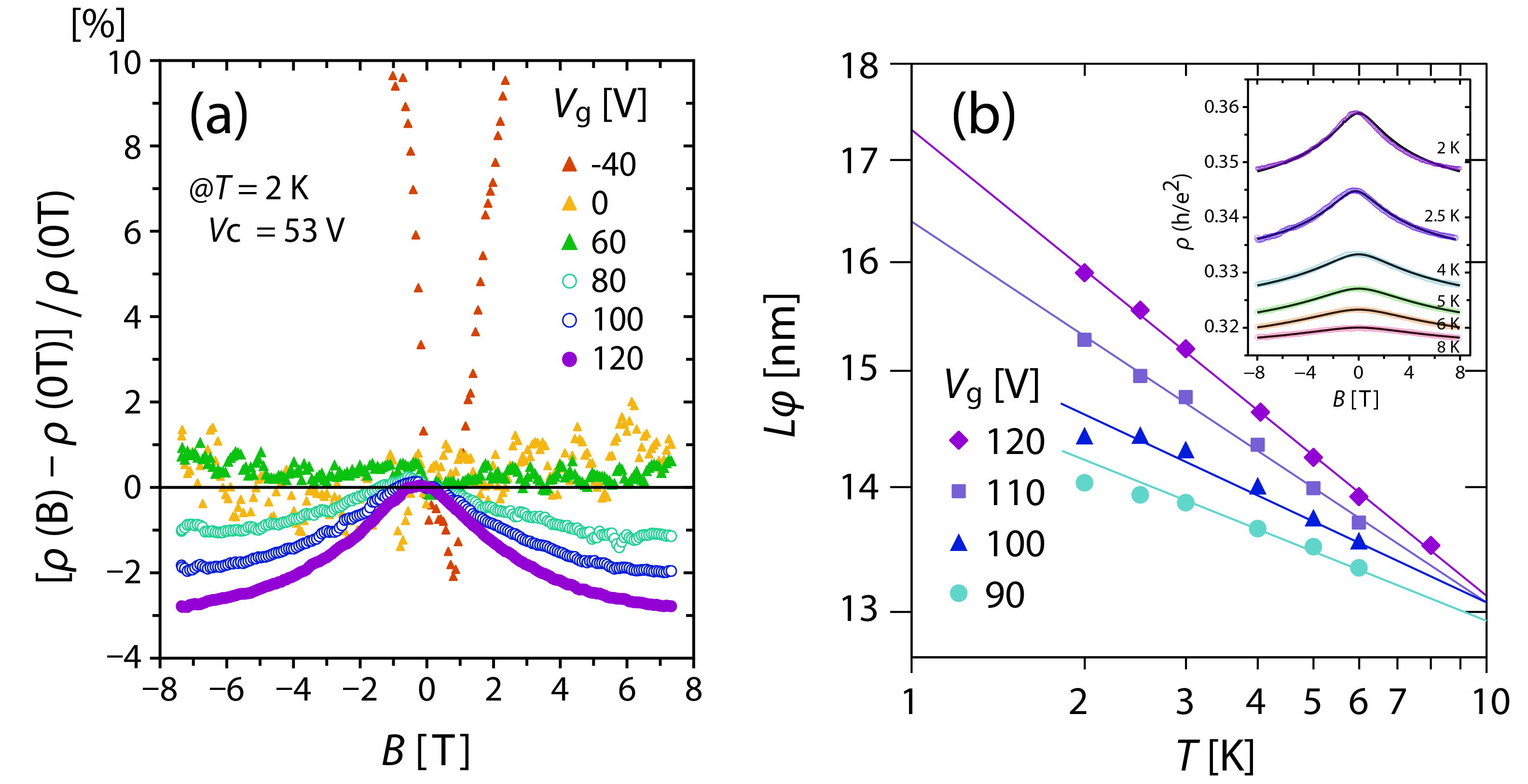
Figure 2: (a) Low-T magnetoresistance on κ-Cl FETüiMI transition occurs at Vg=Vc=53 Vüjσ(B=0)=2.8,2.0,1.4,0.8,0.05,and 7ü~10-6 e2/h for Vg=120,100,80,60,0,and-40 V, respectively.
(b) Weak localization at highly doped regime (main panel) decoherence length (inset) Negative MR at Vg=120 V (highest doping) as a function of T.
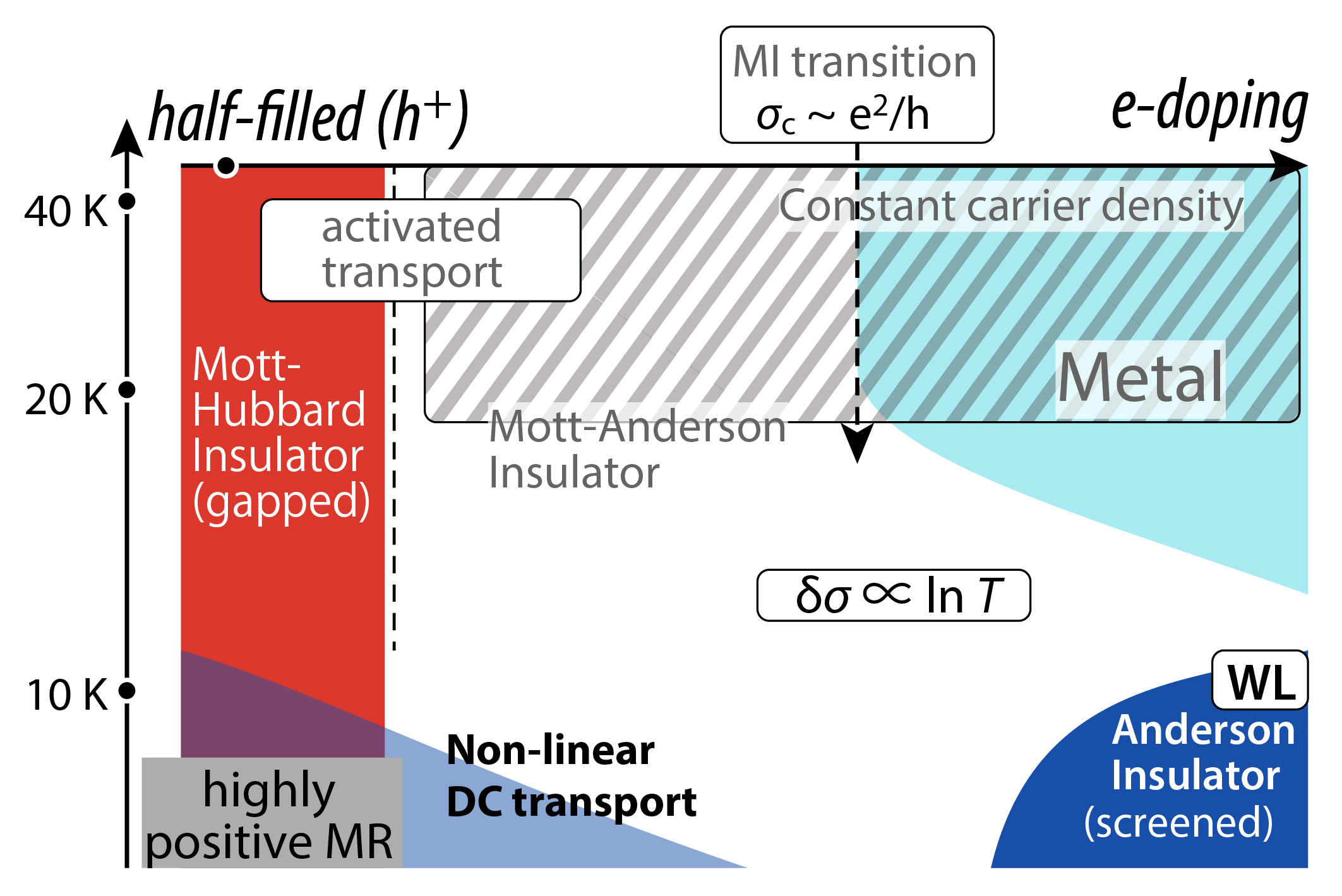
Figure 3: Proposed phase diagram of filling-controlled Mott transition on κ-Cl FET
Assign: Kato; Suda, H. Yamamoto
κ-(BEDT-TTF)2Cu[N(CN)2]Br (κ-Br; BEDT-TTF = bis(ethylenedithio)tetrathiafulvalene) belong to a strongly-correlated electron system, which is located in the vicinity of the Mott transition at low temperature. We recently demonstrated a field-induced superconductivity in a thin-single crystal of κ-Br. On the other hand, in the field of inorganic materials, electric-double-layers (EDL) of ionic liquids have been used in superconducting field-effect transistors as nano-gap capacitors. However, modulations of the carrier density in EDL transistors have been limited to the high-temperature regime because the ionic motions of ionic liquids are frozen below ü`200 K. Here we focused on a novel photo-active EDL system, a spiropyran monolayer (SP-SAM).
We fabricated a photo-active superconducting device by laminating a thin-single crystal of κ-Br on top of a Al2O3/Nb:SrTiO3 substrate covered with SP-SAM (Figure 1). Figure 2 (left) shows the temperature dependence of the resistance after various UV irradiation times at 5 K. In the initial state, the ā╚-Br device exhibited Mott insulating behavior at low temperature. The resistance value decreased with increasing the irradiation time, and when the irradiation time reached 180 s, the device showed an abrupt resistance drop around 7.3 K. This behavior indicates that the system showed a photo-induced phase transition from a Mott insulating phase to a partially superconducting phase. Furthermore, we performed gate voltage sweeps using the bottom-gate structure. Figure 2 (right) shows the contour plots of the resistance as a function of temperature and gate voltage for increasing times of UV light irradiation. The contour plot shifted in the positive voltage direction with elapsed UV light irradiation time, reflecting a gradual progress of the hole carrier injection.
Spiropyrans can switch between a non-ionic isomer and a zwitterionic isomer when triggered by light-irradiation with different wavelengths, resulting in a significant change in the electric dipole moment. Reversible changes in dipole moment of SP-SAM produced two distinct electric fields between the κ-Br and the substrates that created electrostatically doped carriers. Thus, superconductivity could be switched by photo-irradiation by photo-induced EDL formation. The difference in the electric fields between the SP and MC states can be estimated as 4.3 MV/cm, which leads to the accumulated carrier density on the order of 1013 cm-2. This means that SP-SAM EDL can expand the limit of electrostatic carrier doping beyond the density that can be accumulated only by means of a normal FET configuration.

Figure 1: Schematic cross section of the device (left) and photoisomerization reaction of the spiropyran-derivative : Reversible changes in dipole moment of SP-SAM produced two distinct electric fields between the κ-Br and the substrates that created electrostatically doped carriers.
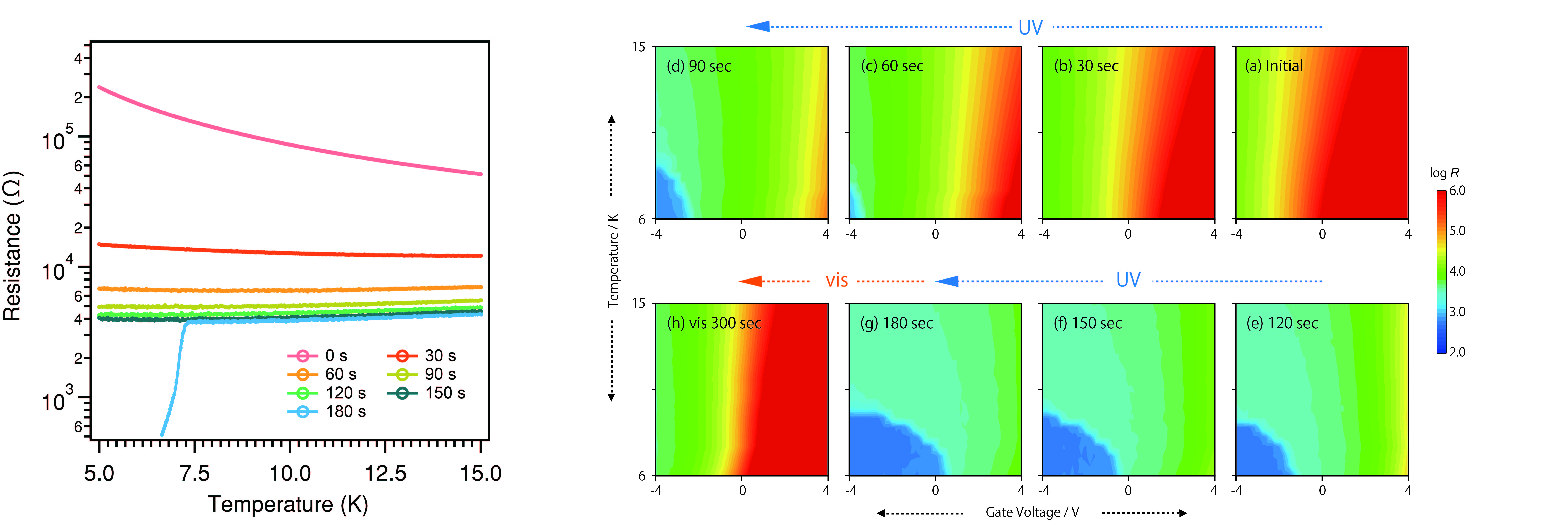
Figure 2üFPhoto-induced Mott insulator-superconductor transition of κ-Br
(left) Resistance versus temperature for the κ-Br device after various times of irradiation with UV light. The resistance value decreased with increasing the irradiation time, and when the irradiation time reached 180 s, the device showed an abrupt resistance drop around 7.3 K.
(right) Evolution of the contour plot of resistance as a function of temperature and gate voltage during the photo-irradiation and extended phase diagram of the κ-Br device. The contour plot shifted in the positive voltage direction with elapsed UV light irradiation time, reflecting a gradual progress of the hole carrier injection.
Assign: Kawasugi, Kato; Tajima, Suda, H. Yamamoto
α-(BEDT-TTF)2I3 with layered structure and tilted Dirac cones (Fig. 1(a)) belongs to a broader category of 2D massless Dirac fermion system. Thus, this material provides us with a testing ground for the transport of the multilayered massless Dirac fermion systems. In this work, we have examined to break the valley symmetry by strong electric field in the magnetic field. According to the realistic theory by Goerbig et. al., strong electric field gives rise to the effects of tilt to the Dirac cones in the magnetic field [M. O. Goerbig, EPL, 85, 57005 (2009)]. Thus, it results in the rift between two Landau levels (Fig. 1(c)). Note that this effect cannot be detected at the N=0 Landau levels. We succeeded in detecting the effects of the valley splitting for N=-1 Landau levels.

Figure 1: (a) Pair of tilted Dirac cone. (b) Landau level structures. (c) Expected Landau level structures in strong electric field.
Assign: Kato; Tsumuraya, Seo, Miyazaki
A new class of molecular conductors containing hydrogen bonds has been synthesized recently; the compounds are based on catechol with ethylenedithiote-tetrathiafulvalene, Cat-EDT-TTF and its diselena analog Cat-EDT-ST. Among them, H3(Cat-EDT-TTF)2 with κ-type dimer arrangement is attracting interests. This compound shows the Mott insulating behavior where localized S = 1/2 spins appear and emerges as a candidate of a quantum spin-liquid down to lowest temperature [1]. In this crystal, every two H(Cat-EDT-TTF) units share a hydrogen (H) atom with a short O-H-O hydrogen bond. In the experimental structure, the H atom is located at exactly the center between two oxygen (O) atoms [2]. The O-O distance is 2.45 Å, and the O-H lengths is 1.23 Å which is much longer than typical covalent O-H bond of ü`1.0 Å. The hydrogen position measured by x-ray diffraction at the center of O-O may be the averaged one due to their thermal or quantum fluctuations.ü@The localization/delocalization of the shared H atom and its influence to the relevant electronic properties have not been fully understood yet.
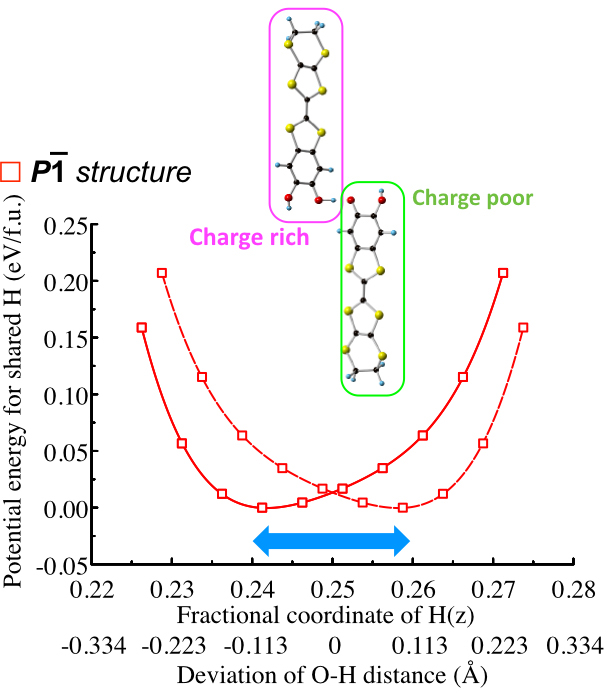
Figure 1: Potential energy curves for the shared H atom in κ-H3(Cat-EDT-TTF)2. Open squares show potential energies for the P-1 structure. The origin of the longitudinal axis is set to be the minimum point of the P-1 structure. The horizontal axis is the fractional z coordinate of the shared H atom located between two O atoms. H (z) = 0.25 corresponds to the center between two O.
In this work, we investigate the electronic and structural properties of κ-H3(Cat-EDT-TTF)2 and κ-H3(Cat-EDT-ST)2 by first-principles density functional theory (DFT) calculations [3]. To understand the localization of the shared H atom, we study the possibility that the H atom binds to one of the two O atoms in spite of the experimental results. We considered an initial position of the H atom, which is closer to O1 (the O1-H1 distance was set to be 1.0 Å), and then relaxed the positions of all the atoms. As a result, we found a stable structure, where the shared H atom is localized to one of the two O atoms. This structure has two inequivalent O-H distances, 1.13 and 1.31 Å, and now there exist two distinct molecules, H2(Cat-EDT-TTF) and H(Cat-EDT-TTF), abbreviated here as w-H and w/o-H units, respectively. To estimate the degree of localization of the proton's wave function, we plot the potential energy curve using the DFT total energies by changing the z coordinate of the H position, where the positions of all the other atoms are fixed at the optimized structure as plotted in Fig.1. There are two curves due to the two equivalent local-minimum structures with H close to either O1 or O2. When the distance between the two minima is sufficiently short, and the potential between the minima is shallow, the proton wave function becomes centered at the bond midpoint. This is actually the case here, and then we expect that the distribution of the proton cannot be localized close to one of the two O atoms.
We also find charge disproportionation between the two types of H(Cat-EDT-TTF) units in the H-localized structure. The band structure of the optimized H-localized structure are shown in Fig.2(a). One can see the splitting of the bands near the Fermi level at Z-point. As shown in Fig.2 (b), the local density of states (LDOS) clearly shows charge imbalance; the occupied state of the energy range around -0.1 ü` 0 eV, the LDOS for the w-H unit increases but that of the w/o-H unit decreases. On the other hand, above the Fermi level from 0 to +0.2 eV, the LDOS shows the opposite behavior. Here we would like to emphasize that a stable H-localized structure found theoretically and shows a different electronic structure owing to the charge disproportionation between two types of molecules.
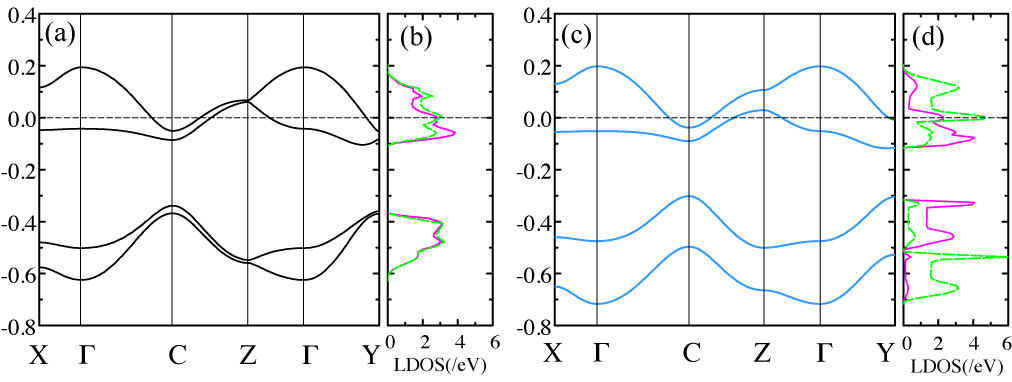
Figure 2. (a) Band structure of optimized H-localized (P-1) structures of κ-H3(Cat-EDT-TTF)2. (b) Local density of states (LDOS) of the H(Cat-EDT-TTF) with P-1 structures. The latter contains two parts, H2(Cat-EDT-TTF) (pink solid curve) and H(Cat-EDT-TTF) (green broken curve). (c) Band structures of optimized D-localized (P-1) structures of κ-D3(Cat-EDT-TTF)2. LDOS which is summation of the partial DOS from C-p, S-p, O-p, and H-s states belonging to H(Cat-EDT-TTF) part. The origin of the vertical axis with a dashed line shows the Fermi level.
In fact, a recent experiment found a non-magnetic charge disproportionation state induced by a deuterium (D) substitution [4, 5]. It is natural to expect D to be localized around one of two atoms due to the reduction of quantum fluctuation. The band structure for the optimized structure of the D-sample is plotted in Fig.2(c). The band splitting between two bands crossing the Fermi level is larger than that of our predicted H-localized structure as plotted in Fig. 2(a). The charge imbalance seen in the LDOS shows a similar tendency as in the H-localized structure, but the degree of charge disproportionation of D-sample is much larger than those in Fig. 2(b). This can be understood by the fact that the measured D-localized structure has a much larger lattice distortion than the H-localized one. We also performed geometrical optimization for the observed D-structure, and then we compared relative stabilities between the two structures. As a result, the H-localized structure is more stable than the D-localized state.
Lastly, we also discuss possible hydrogen ordering patterns. Here we consider two different patterns of H-localized structure. The pattern of the H localized structure discussed above is assumed to be the same as the observed D-structure as shown in Fig. 3(a). In this pattern, a pair of w-H (or w/o-H) molecules forms dimer (the space group: P-1). On the other hand, when the two different shared H atoms in two H(Cat-EDT-TTF)2 dimers move different directions, w-H and w/o-H molecules can form a dimer [Fig. 3(b)]. This structure does not have the space inversion symmetry (P1), and the ferroelectricity can be induced by the H ordering. To discuss the structural stability between the two structures, we performed geometrical relaxation. However, two structures are energetically competitive each other.

Figure 3: Two different hydrogen order patterns: (a) P-1 structure (antiferroelectric) and (b) P1 structure (ferroelectric).
References
[1] T. Isono, H. Kamo, A. Ueda, K. Takahashi, M. Kimata, H. Tajima, S. Tsuchiya, T. Terashima, S. Uji, and H. Mori, Phys. Rev. Lett., 112, 177201(2014).
[2] T. Isono, H. Kamo, A. Ueda, K. Takahashi, A. Nakao, R. Kumai, H. Nakao, K. Kobayashi, Y. Murakami, and H. Mori, Nat. Commun., 4, 1344 (2013).
[3] T. Tsumuraya, H. Seo, R. Kato and T. Miyazaki, Phys. Rev. B, 92, 035102 (2015).
[4] A. Ueda, S. Yamada, T. Isono, H. Kamo, A. Nakao, R. Kumai, H. Nakao, Y. Murakami, K. Yamamoto, Y. Nishio, and H. Mori, J. Am. Chem. Soc., 136, 12184 (2014).
[5] A. Ueda, A. Hatakeyama, M. Enomoto, R. Kumai, Y. Murakami, and H. Mori, Chem. Eur. J., 21, 15020 (2015).
Assign: A-Jawad, Kato; Watanabe, Tajima, Ishii
The metal-insulator transition of the Mott type can be achieved in two ways. Filling-controlled Mott transitions are achieved by adding charge carriers through chemical doping or electric field while bandwidth-controlled Mott transitions require the control of the ratio U/W between the on-site Coulomb repulsion, U and the bandwidth, W. Bandwidth-controlled Mott transitions can be achieved by chemical pressure or, as in this study, by physical pressure in various media. By performing pressure sweep measurements of the conductivity, σ at constant temperature (isothermal) in (V1-xCrx)2O3, Limelette et al.[1] found that σ on the metallic side of a three-dimensional Mott insulator could be scaled. From those scalings, they extracted critical exponents of the transition which were consistent with Ising universality class. The same measurement was subsequently performed in κ-(BEDT-TTF)2Cu[N(CN)2]Cl [2], a quasi-two-dimensional (quasi-2D) organic conductor, where BEDT-TTF stands for bis(ethylenedithio)tetrathiafulvalene. This subsequent study showed that although the conductivity on the metallic side of the phase diagram could still be scaled around the critical endpoint, the extracted critical exponents were inconsistent with any of the known universality class. NMR data in the same quasi-2D compound [3] further support those anomalous critical exponents while thermal expansion [4] measurements in the same class of compounds found critical exponents that do correspond to 2D Ising universality class. Theoretical interpretations of those results are either in support of the unconventional critical exponents values or against.
To resolve the issue of the critical nature of the Mott transition, we have performed isothermal pressure measurement, with helium as pressure medium, of the conductivity, σ and thermoelectric power coefficient, SB in Pd(dmit)2 based compounds. Figure 1 shows the results in EtMe3P[Pd(dmit)2]2 [5], a quasi-2D molecular conductor. Surprisingly, it is found that SB exhibits a sharp minimum in its pressure dependence at the Mott transition. Using this minimum of SB, we were able to determine objectively the pressure and temperature limit of the Mott transition. By reinterpreting the relation between σ and the scaling exponents, we were able to give a consistent scaling of σ and SB to a 2D Ising universality class from all measurements.
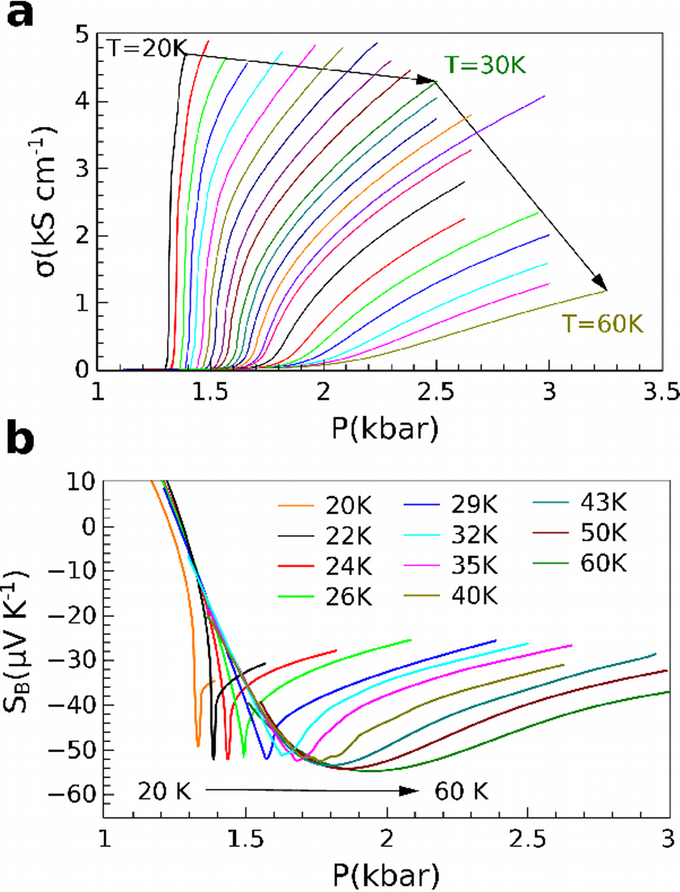
Figure 1: Limited data set of the isothermal pressure dependence of the conductivity and the Seebeck coefficient from EtMe3P[Pd(dmit)2]2. (a) Pressure dependence of the conductivity. Temperature steps are 1 K between 20 K and 35 K. Above 35 K, the temperatures are 37 K, 40K, 43 K, 46 K, 50 K, 54 K and 60 K. (b) Pressure dependence of the Seebeck coefficient.
Recently, we have performed similar isothermal pressure dependent measurements of σ and SB in EtMe3Sb[Pd(dmit)2]2 a quantum spin-liquid candidate compound [6]. Figure 2 shows the results. Compared to the previous case, the change in SB through the Mott transition is very different; no minimum values of SB are found at the Mott transition. Instead SB is found to be almost temperature independent in the metallic state, this behavior of SB is consistent with high temperature incoherent transport where kBT»t, the transfer integral. This low temperature incoherent transport of the metallic state arises most probably from a very high scattering rate of the charge transport, consistent with the low σ values from Fig. 2 a. The origin of this high scattering rate is unclear. It could come from the intrinsic disorder of the EtMe3Sb cation layer or more interestingly from the quantum spin-liquid nature of this compound.
It is clear that the Mott transition in EtMe3P[Pd(dmit)2]2 and EtMe3Sb[Pd(dmit)2]2 represent contrasting examples. The first compound represents the clean limit of a Mott transition while the second compound represents the disordered limit of a Mott transition. Further work on other Pd(dmit)2 based compounds with varying degrees of frustrations will be needed to resolve the effect of geometrical frustration and the nature of charge transport and the Mott transition.
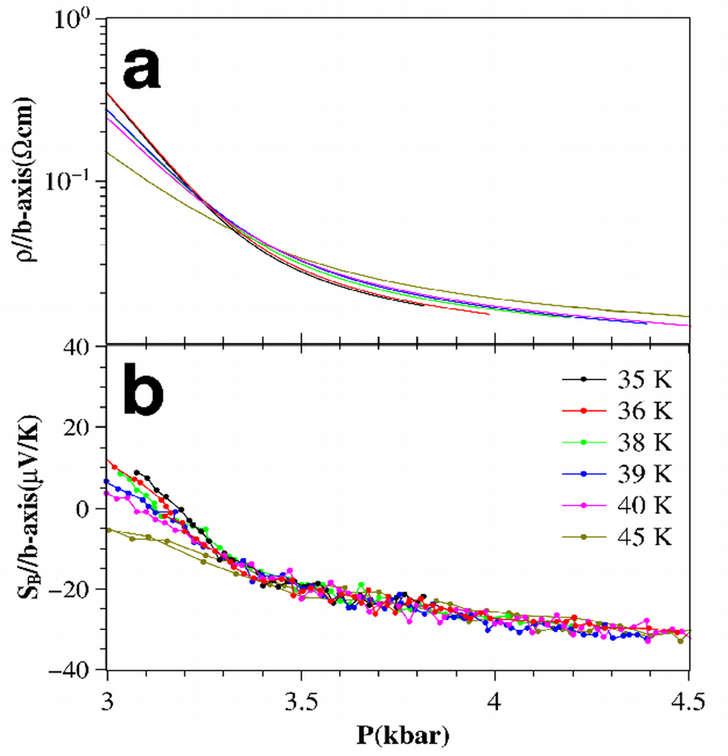
Figure 2: Isothermal pressure dependence of the conductivity and the Seebeck coefficient from EtMe3Sb[Pd(dmit)2]2 with Helium as pressure medium. (a) Pressure dependence of the resistivity. (b) Pressure dependence of the Seebeck coefficient.
References:
[1] P. Limelette, A. Georges, D. J?rome, P. Wzietek, P. Metcalf, and J. M. Honig, Science, 302, 89 (2003).
[2] F. Kagawa, K. Miyagawa, and K. Kanoda, Nature (London), 436, 534 (2005).
[3] F. Kagawa, K. Miyagawa, and K. Kanoda, Nat. Phys., 5, 880 (2009).
[4] L. Bartosch, M. de Souza, and M. Lang, Phys. Rev. Lett., 104, 245701 (2010).
[5] M. Abdel-Jawad, R. Kato, I. Watanabe, N. Tajima, and Y. Ishii, Phys. Rev. Lett., 114, 106401 (2015).
[6] T. Itou et al, Phys. Rev. B, 77, 1044 (2008).












